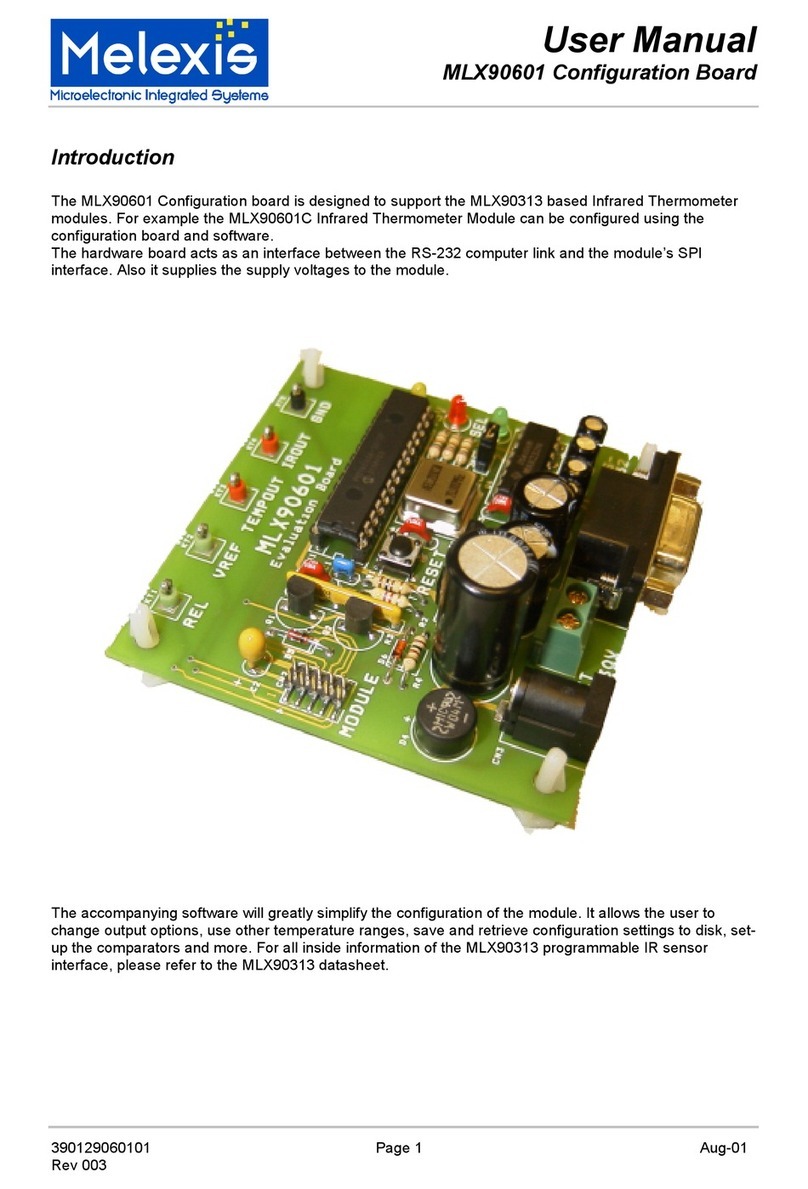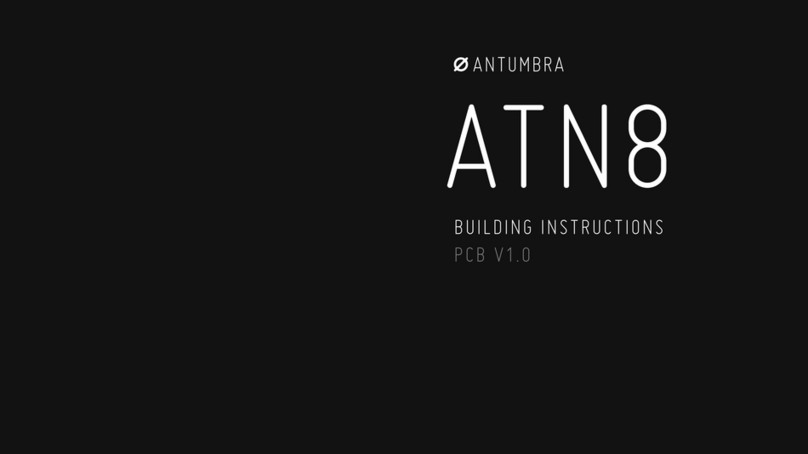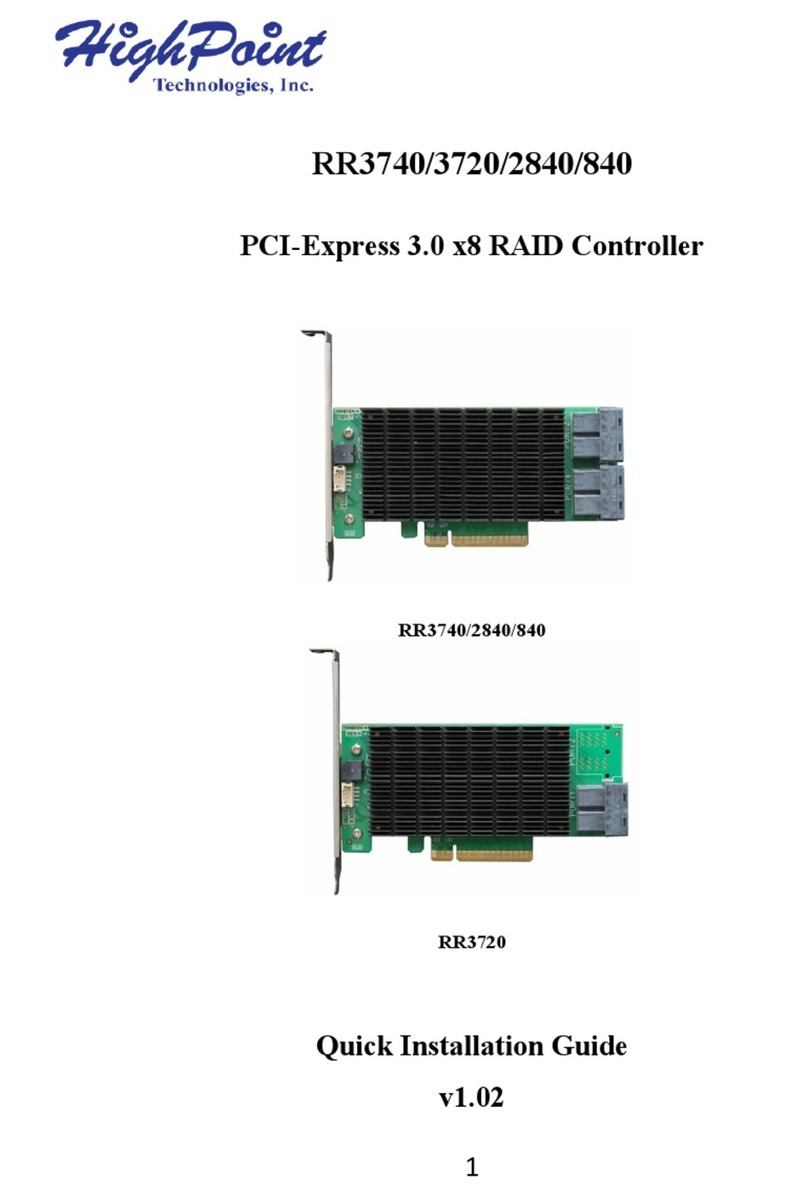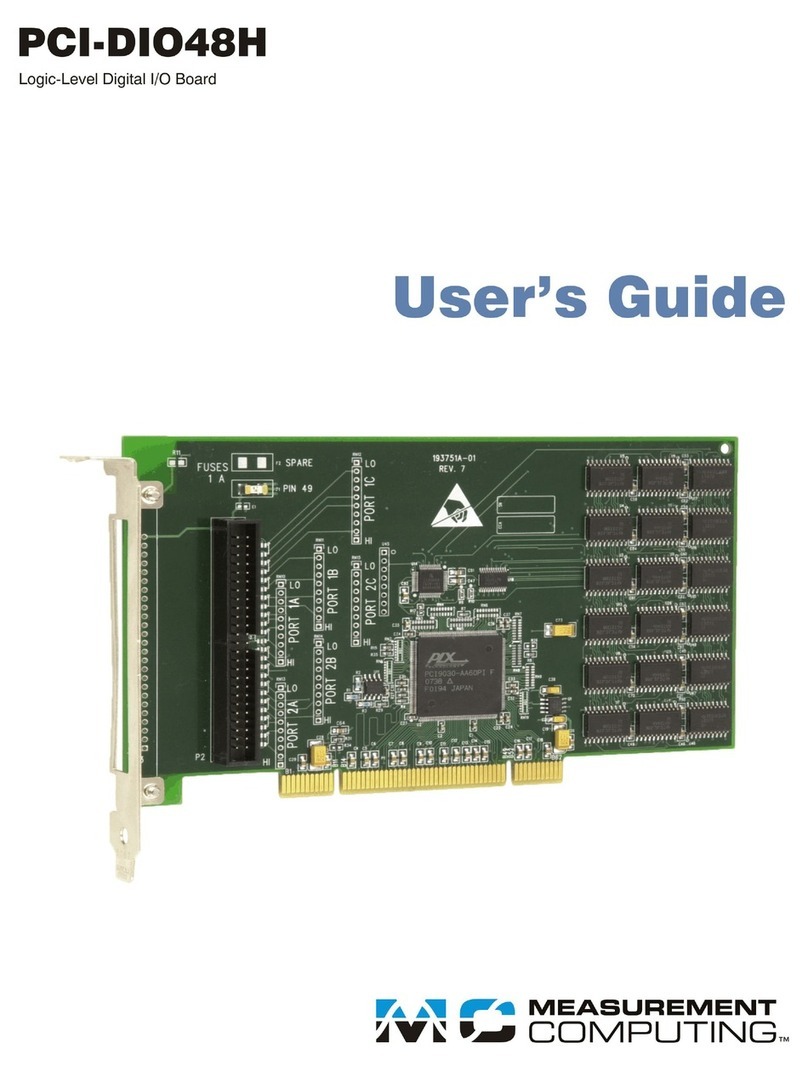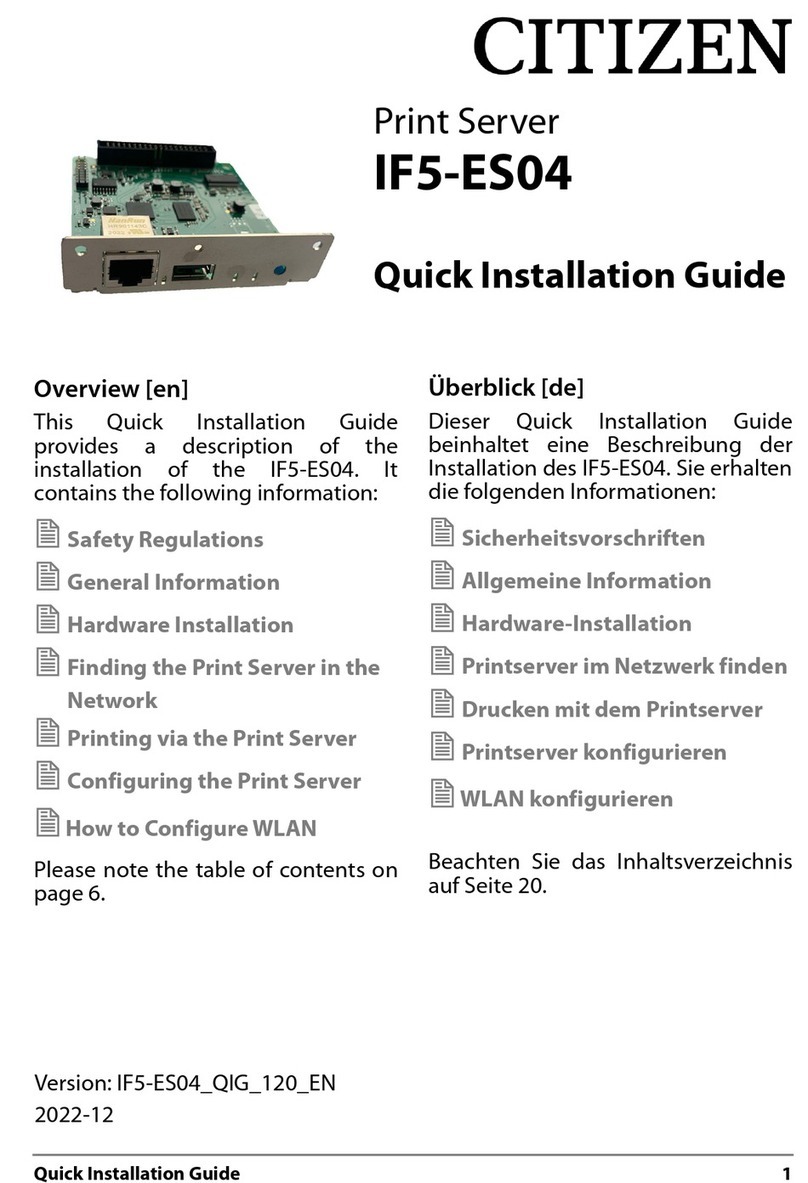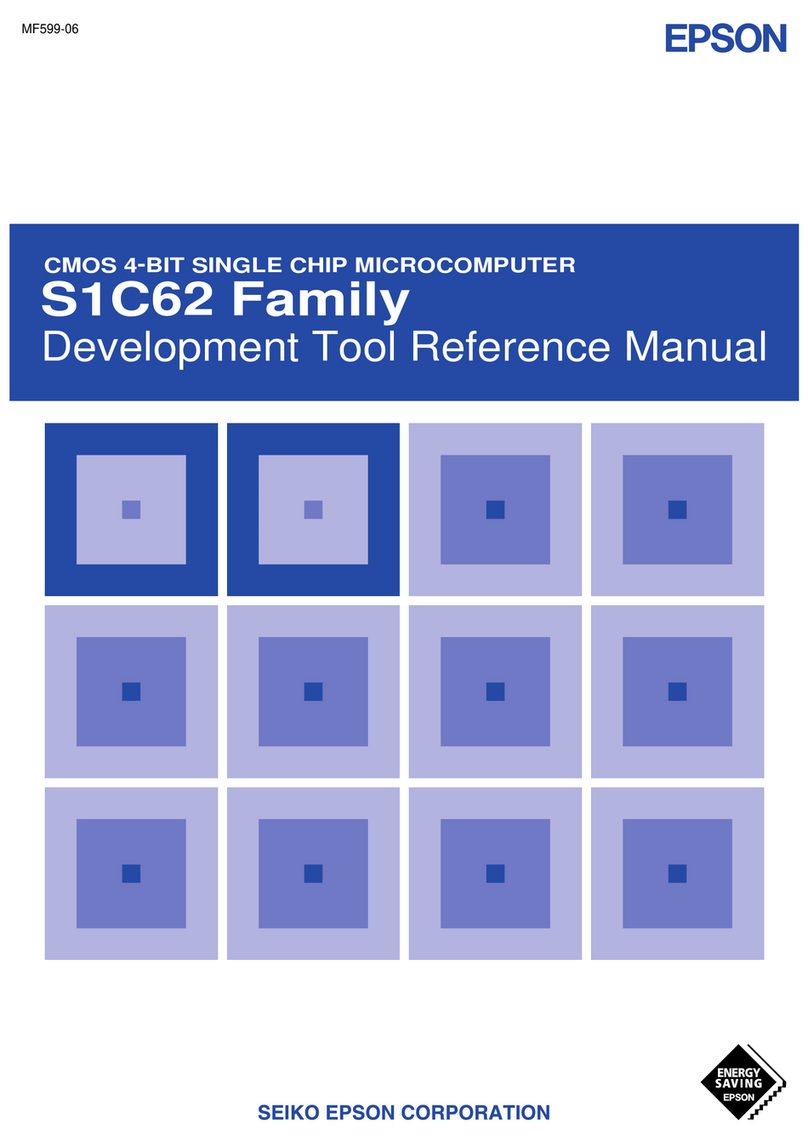Melexis DEMO90121LR User manual

DEMO90121LR
RFID Long Range Demo User Manual
390129012104 Page 1 of 19 User Manual
Rev 003 Dec. 2009
Features and Benefits
Output power of 1Watt
Supports ISO15693 international standard
RS232 communication
30$ BOM cost target
Application Examples
Asset tracking
Library’s book inventory control
Bicycle rental checkout
Ordering Information
Part No. Description
DEMO90121LR Long Range Demonstrator
1 Scope
The DEMO90121LR is a turnkey contactless
long range reader example based on the
RFID transceiver IC MLX90121. Once set up,
it can inventory and access ISO15693
compliant tags and cards by sending
corresponding commands.
The DEMO90121LR is connected to a
computer through its RS232 serial interface.
The Melexis user interface program UT121
can be used for easy and fast evaluation of
the demonstrator. The form factor is
minimized to demonstrate the high level of
integration allowed by the MLX90121. The bill
of material for DEMO90121LR targets a cost
of 30$ per component set for 1000 modules.
Complete schematics, bill of material and
layout are annexed to this document allowing
a fast start for development work. Source
code of the firmware is based on the
FW90121 library and is available on the CD
ROM provided with the DEMO90121LR. This
device is based on ISO15693 RFID standard,
maximizing the operating distance.
This document includes fast start instructions,
describes the performance of the demo and
explains its hardware and software. The
demo and documentation are a starting point
for building customized long range reader
systems by adapting the functions and
performance to meet specific requirements.
2 Related Melexis product
MLX90121 – 13.56MHz transceiver
Important note:
The device is for
demonstration purpose and has not been
tested for compliance with FCC, ETSI or
any other regulations.
Downloaded from Elcodis.com electronic components distributor

DEMO90121LR
RFID Long Range Demo User Manual
390129012104 Page 2 of 19 User Manual
Rev 003 Dec. 2009
Table of Contents
1 Scope...........................................................................................................................................1
2 Related Melexis product.............................................................................................................1
3 Introduction.................................................................................................................................2
4 Box Content ................................................................................................................................3
5 Connections ................................................................................................................................4
6 Function and use ........................................................................................................................4
7 Observations...............................................................................................................................4
8 Hardware .....................................................................................................................................5
8.1 General ..................................................................................................................................5
8.2 MLX90121 Power Booster ....................................................................................................5
8.3 Progressive Field increase...................................................................................................6
8.4 Serial interfaces ....................................................................................................................6
8.5 Power supplies and LEDs ....................................................................................................7
8.6 SPI and Serial memory .........................................................................................................8
8.7 External push button ............................................................................................................9
8.8 Microcontroller ATmega8.....................................................................................................9
8.9 RFID Antenna ......................................................................................................................10
9 Firmware....................................................................................................................................12
9.1 Structure..............................................................................................................................12
9.2 Practical information ..........................................................................................................13
9.3 Instruction set .....................................................................................................................13
10 Conclusion ..............................................................................................................................14
11 Annexes...................................................................................................................................15
11.1 Schematics........................................................................................................................15
11.2 List of components...........................................................................................................17
11.3 RFID Antenna Layout .......................................................................................................19
3 Introduction
You purchased a DEMO90121LR. Thank you for choosing Melexis RFID solutions. This document contains
the instructions to use and evaluate the functions and the performance of this demonstrator. All the
necessary hardware is provided in the packaging box and the microcontroller on-board is pre-programmed
with the firmware on the included CD. All that you need to do is connect the cables, start the
UT121
user
interface program, and then to send predefined ISO15693 commands to see the displayed answer from a
compatible transponder(s) placed in front of the long range antenna.
Should you want to start a development based on this demonstrator, you will find in this document and on the
CD all information, like schematics, board layout, list of components, firmware source (C code) and the
related application note. Please note that all this material is provided to support the use of the related Melexis
product. Duplication, circulation or storage on data carriers in any manner for any other type of use are not
authorized by Melexis unless under a specific agreement.
Downloaded from Elcodis.com electronic components distributor

DEMO90121LR
RFID Long Range Demo User Manual
390129012104 Page 3 of 19 User Manual
Rev 003 Dec. 2009
4 Box Content
You will find in the box the following components.
•1 RFID Reader Board
Figure 1: RFID reader board. Top side
•1 Board antenna
Figure 2: Antenna ANT3_0
Antenna connector
(SMA)
RS232 connector
Power supply connector
Downloaded from Elcodis.com electronic components distributor

DEMO90121LR
RFID Long Range Demo User Manual
390129012104 Page 4 of 19 User Manual
Rev 003 Dec. 2009
•3 Transponder (Inlays or cards) ISO15693
•1 Power supply block with adaptor
•1 serial cable RS232
•1 CD with the firmware and documentation
The delivered CD contains the complete documentation of the hardware and firmware for
DEMO90121LR, User Manual, Datasheet MLX90121, Source Code of the firmware (written in C,
flavor AVR gcc), Hex file of the firmware, Bill of materials of the board, UT121 software (PC user
interface)
•1 Box Content (on paper)
5 Connections
The first step is to connect the component. Connect antenna board to the RFID reader board using the SMA
connector. Then, connect the serial cable from the computer to the RS232 connector (CON5). Finally,
connect the power supply block to the jack connector (CON6). The two LEDs D5 and D6 must be switched
ON.
Important note: Should you want to connect you own power supply, please note that in order to avoid extra
power dissipation, a maximum power supply (CON6) of 15 volts must be applied.
6 Function and use
Once connected, the demonstrator is able to receive commands sent through the RS232 serial interface. The
firmware of the DEMO90121LR handles the RFID communication, according to the ISO15693 international
standard up to the level 2. Meaning that the Start Of Frame, the End Of Frame and the CRC calculation and
check is supported by the firmware while, the protocol understanding has to be managed by a higher level of
application software.
The communication with the long range demonstrator can be established by any RS232 terminal by
configuring the following parameters:
•Data rate = 57600 BAUD
•Data bit = 8bits
•Parity = None
•Stop bits = 1
•Flow control = Hardware
For an easy and fast evaluation, the DEMO90121LR is supplied with the
UT121
Melexis user interface. For
more information on how to install and use the
UT121
, please refer to the documentation
DVK90121
User
Manual.
After starting the user interface program, one will have access to a list of predefined commands to start the
communication with the demonstrator and with the ISO15693 transponders. For more information on the
command format supported by the DEMO90121LR, please refer to the chapter Firmware below.
7 Observations
•The delivered output power is 1 Watt to a 50-ohm load.
•Reading range of the DEMO90121LR is about 28cm in ISO15693 dual sub-carrier.
•The power consumption with the field ON is about 300 mA.
•The DEMO90121LR supports the Anti-collision procedure. Therefore, several transponders can be
put in the field and the Anti-collision command can be sent. The unique identifier (UID) of every
transponder detected will be returned.
Downloaded from Elcodis.com electronic components distributor

DEMO90121LR
RFID Long Range Demo User Manual
390129012104 Page 5 of 19 User Manual
Rev 003 Dec. 2009
8 Hardware
8.1 General
The DEMO90121LR is built around the MLX90121 RFID transceiver front-end and the 8bit microcontroller
Atmel ATMega8. The MLX90121 handles the air interface in transmission and in reception. It drives the
antenna through a power booster configuration to provide up to 1Watt of output power to the 50-ohm
antenna. It demodulates the tag answer using an external diode detector to reduce the power fed into the
MLX90121 reception pin. The ATMega8 runs the protocol and the application software. The board has three
interfaces, two for the RS232 and RS485 serial interfaces and a SPI connection for the uC programming. It
includes a reset button and two linear regulators of +5 and +12V DC.
8.2 MLX90121 Power Booster
The power booster schematic is implemented according to the application note “A Power Booster for the
MLX90121” included in the “MLX90121 Cookbook”. For more information about the theory of operation,
please refer to this document available on the Melexis WEB-site.
L2
560NH
C23
100NF
ANTENNA1
1
2
short!
GND_TX
GND_TX
L6
BLM31AJ260SN1
CV1
5.5-50PF/200V
R11
6.8
12
DSY NC
CLK13M
C15
220Pf
GND_RX
5V
C5
100NF
short!
C12
100nF/50V
GND_uC
R5
680
1 2
C21
22PF
short!
RTB
TAG Reader MLX90121
Close to
ANTENNA
connector
C8
10NF
GND_1W
short!
RSSI
C9
33PF
R10
51
12
10M
R13
1 2
short!
short!
GND_1W
C6
4.7UF/TANTAL
12
C3
100NF
TP1
GND
1
C22
22PF
Close to
MLX90121 pin 2
GND_1W
5V
Y1
13.56MHZ
GND_TX
DOUT
GND_TX
GND_RX
Close to
MLX90121 pin 2
5V
GND_1W
Q2
IRFD110
1
3
4
2
R9
1K5
1 2
GND_RX
short!
L3
680NH
Close to
MLX90121 pin 3
Det_in
GND_1W
R6
27K
1 2
C19
2.2NF
C24
220PF
R12
10K
12
L5
3.3UH
short!
C4
4.7UF/TANTAL
12
Edge of the
board
GND_RX
GND_TX
Det_in
D3
BAS16
1 3
GND_1W
R8
22K
1 2
short!
L7
270NH
DIN
GND_TX
C20
100PF
C13
330PF
U2 MLX90121
1
2
3
4
5
6
7
8
9
10
20
19
18
17
16
15
14
13
12
11
VDD 1
TX
MOD
VSS1
XOUT
XIN
VSS2
XBUF
NC
RTB
RX
VSS3
NC
VDD3
DSY NC
CK
MODE
DIN
VDD2
DOUT
MSI
GND_1W
R3
10E
1 2
C14
100NF
GND_uC
short!
C10
XXPF/200V
GND_1W
GND_TX
L1
BLM31AJ260SN1
M1
PMBF170
1
3
2
short!
GND_1W
Vdd
MODE
CK
C18
100PF/100V/NPO
GND_1WL4
2.2UH
D4
BAR18
13
short!
Figure 3: TAG Reader MLX90121 in power booster configuration
The output of the long range reader is matched for 50-ohm loads. In case other impedance values or more
filtering are required, the capacitor C10 can be mounted to form a πfilter with L4 and CV1. The output power
supply Vdd is fixed to 12V by a linear regulator to provide 1 watt of output power.
The modulation depth is fixed to about 100% according to the ISO15693 specification. The resistors R10,
R12 and the transistor M1 are anticipated in the layout to adjust the modulation depth on the fly by the
microcontroller. This function is not used in the DEMO90121LR and these components are not mounted.
To avoid any perturbation, the MLX90121 use its own 13.56MHz signal provided by the crystal resonator Y1.
This signal can be supplied by the microcontroller ATmega8 by replacing the capacitor C24 with a jumper
wire. Care should be taken that the crystal oscillator has to be removed and the microcontroller has to be
configured to be able to drive the clock of the MLX90121. To improve the performance of the long range
reader, the external diode detector solution was chosen to receive the modulation signal from the
transponder (R9, D4, C20, R8 and C19). The C12 capacitor decouples the DC level to protect the diode of
the detector from high voltages.
Downloaded from Elcodis.com electronic components distributor

DEMO90121LR
RFID Long Range Demo User Manual
390129012104 Page 6 of 19 User Manual
Rev 003 Dec. 2009
8.3 Progressive Field increase
It has been observed that some RFID transponders do not operate properly when the field intensity reaches
its maximum in a very short time. Consequently, a progressive field increase mechanism was implemented.
For more information about the theory of operation, please refer to the application note “Progressive Field
Increase for the MLX90121” in the “MLX90121 Cookbook” available on the Melexis internet site
(www.melexis.com).
R1
4K7
1 2
PFI
R4
10K
12
C11
100NF
12V
C1
10UF/TANTAL
12
Vdd
R2
2K2
1 2
Q1
FDC6327C
1
3
5
2
6
4
G1
G2
S1
S2
D1
D2
C2
100NF
Figure 4: Soft Start PWM Drive
Important note: The Progressive field increase method is not implemented in the version 1.0 of the firmware
but could be in the next revision. Please contact your Melexis representative to get the last revision of the
firmware. The description of the change in the revision list of the firmware will give an indication if the function
has been implemented.
8.4 Serial interfaces
The demonstrator can be externally controlled with an RS232 (CON5 or CON3) or RS485 (CON2) serial
interfaces. The reception signal Rx can be selected from RS232 or RS485 by firmware with the bit
RS232_485.
RX
U7C
74HC00PW
9
10
8
147
C42
100NF
GND_uC
RS232_485
U7A
74HC00PW
1
2
3
147
RX485
U7D
74HC00PW
12
13
11
147
U7B
74HC00PW
4
5
6
147
RX232
+5V
GND_uC
Figure 5: RS485/RS232 Rx signal switch
The RS232 allow for connecting the board to a serial COM port of a computer through the serial connector
RS232. The voltage level is adapted using the MAX202 RS232 transceiver (U1).
U1
MAX202CSE
13
8
11
10
1
3
4
5
2
6
12
9
14
7
16
15
R1IN
R2IN
T1IN
T2IN
C+
C1-
C2+
C2-
V+
V-
R1OUT
R2OUT
T1OUT
T2OUT
VCC
GND
C43
1uF
+5Vser
TX
C44
100NF
C39
100NF
C40
100NF CON3
RS232
1
2
3
+5Vser
GND_Ser
RX232
C41
100NF
GND_Ser
Downloaded from Elcodis.com electronic components distributor

DEMO90121LR
RFID Long Range Demo User Manual
390129012104 Page 7 of 19 User Manual
Rev 003 Dec. 2009
Figure 6: RS232 transceiver
The RS485 is a complement to the RS232 serial connection as it allows connecting several devices on the
same bus. The voltage level conversion is controlled by the LMS485 transceiver (U6). The communication is
controlled by the signals 485_DE (Output driver enabled, for DATA transmission). A termination load of 120-
ohms (R27) is also available to correctly match the end of the RS485 cable (Jumper CON4).
L8
BLM31AJ260SN1
TX
R27
120
1 2
D12
SMBJ12CA
L11
B82789
2
1
4
3
+5V
485_DE
U6
LMS485IM
1
4
5
8
2
3
6
7
RO
DI
GND
VCC
RE
DE
A
B
C38
4.7UF/TANTAL
12
GND_Ser
GND_Ser GND_Ser
CON2
RS485
1
2
3
GND_Ser
RX485
CON4
RS485_TER
1
2
GND_Ser
D11
SMBJ12CA
C36
100NF
GND_Ser
+5Vser
Figure 7: RS485
8.5 Power supplies and LEDs
The DEMO90121LR is supplied through the connector CON6. A protection diode D1 protects the board from
supply inversion while a suppression diode D2 protects against over voltage. Two linear regulators have been
chosen to provide clean power supplies of +12 volts for the power booster circuit and +5 volts for the
MLX90121 and the microcontroller. Two LEDs are available at the output of the regulators (D5 and D6) to
indicate operation of the power supplies.
U3
7805C
1
2
3
VI
GND
VO
Vpower
R14
7K5
1 2
C26
100NF
D1 and F1
not
assembled
in the same
time
C27
100NF
D2
SMBJ22A
2
1
R7
7K5
1 2
5V
C16
100NF
Vpower
L9
BLM31AJ260SN1
C7
10UF/TANTAL/35V
12
CON1
POWER
1
2
D1
30BQ060 SMD
1 2
12V
C25
10UF/TANTAL
12
U10
7812C
1
2
3
VI
GND
VO
0451.500MRL
D5
1
2
F1
Or
Edge of the
board
Vpower
+5V
C17
100NF
D6
1
2
Figure 8: Power supplies
Downloaded from Elcodis.com electronic components distributor

DEMO90121LR
RFID Long Range Demo User Manual
390129012104 Page 8 of 19 User Manual
Rev 003 Dec. 2009
Three additional LEDs can be controlled by the firmware. In the version 1.0 of the firmware, the LEDs D8, D9
and D10 will be always switched ON.
R23
7K5
1 2
R24
7K5
1 2
D9
1
2
GND_uC
D10
1
2
LEDserial
D8
1
2
LEDmlx LEDgeneral
GND_uC GND_uC
R26
7K5
1 2
Figure 9: LEDs
8.6 SPI and Serial memory
An external serial memory of type FRAM is available to store the current UIDs of the RFID transponders
inventoried in the field, in stand alone mode. It is accessed by the microcontroller through the SPI serial
interface (MISO, MOSI and SCK). The FRAM has to be selected using the signal EEPROM_CS.
5V
GND_uC
5V
MISO
MOSI
SCK
EEPROM_CS
5V
C29
100NF
U4
FM25C160
3
4
5
2
6
1
7
8
|WP
VSS
SI
SO
SCK
|CS
|HOLD
VCC
GND_uC
Figure 10: Serial memory
Important note: The stand alone application is not implemented in the version 1.0 of the firmware but could
be in the next revision. Please contact your Melexis representative to get the latest revision of the firmware.
The description of the change in the revision list of the firmware will give an indication if the function has been
implemented.
The connector J1 is used to program the microcontroller with the application firmware.
1K
R15
1 2
CH_SCK
CH_MISO
1K
R17
1 2
CH_MOSI
1K
R16
1 2
GND_uC
MOSI
CH_RST
MISO
100
R19
1 2
SCK
J1
1
3
5
7
9
2
4
6
8
10
+
+
+
+
+
+
+
+
+
+
ISP
5V
C28
100NF
RST
Figure 11: Microcontroller programming
Downloaded from Elcodis.com electronic components distributor

DEMO90121LR
RFID Long Range Demo User Manual
390129012104 Page 9 of 19 User Manual
Rev 003 Dec. 2009
8.7 External push button
The button BUTTON1 is used to perform hardware reset of the DEMO90121LR board.
Important note: The extra button BUTTON2 is not implemented in the version 1.0 of the firmware but could
be in the next revision. Please contact your Melexis representative to get the latest revision of the firmware.
The description of the change in the revision list of the firmware will give an indication if the function has been
implemented.
5V
C37
100NF
GND_uC
RSTsof tRST
BUTTON1
BUTTON_RESET
1 2
3
4
D7
BAS16
1 3
GND_uC
5V
GND_uC
BUTTON2
BUTTON_RSTSOFT
1 2
3
4
GND_uC
8K2
R25
1 2
C45
1NF
8K2
R22
1 2
Figure 12: Push buttons
8.8 Microcontroller ATmega8
The DEMO90121LR is controlled by an Atmel microcontroller ATmega8. It contains the firmware example
written by Melexis to handle the RFID communication and the serial communication with a computer.
The microcontroller also controls the progressive field increase (PFI) block, the external FRAM through the
SPI serial interface, the RS232/RS485 selection and the LEDs.
short!
CLK13M
SCK
5V
GND_ADC
MISO
MODE
C34
22PF
short!
LEDmlx
C33
100NF
CK
short!
C30
10NF
GND_ADC
GND_uC
RX
RST
8K2
R20
1 2
EEPROM_CS
RSTsof t
GND_uC
TX
485_DE
RTB
RSSI
L10
BLM31AJ260SN1
PFI
GND_ADC
DOUT
DIN
C35
22PF
ATmega8
U5
ATMEGA8-16AU
1
2
3
4
5
6
7
8
9
10
11
12
13
14
15
16
17
18
19
20
21
22
23
24
25
26
27
28
29
30
31
32
PD3
PD4
GND
VCC
GND
VCC
PB6
PB7
PD5
PD6
PD7
PB0
PB1
PB2
PB3
PB4
PB5
AVCC
ADC6
AREF
GND
ADC7
PC0
PC1
PC2
PC3
PC4
PC5
PC6
PD0
PD1
PD2
RSSI_f il
LEDgeneral
C31
10NF
MSI
RS232_485
Y2
13.56MHZ
short!
5V
DSYNC
C32
100NF
LEDserial
10M
R21
1 2
GND_uC
MOSI
GND_ADC
R18
100
Figure 13: Microcontroller ATmega8
Downloaded from Elcodis.com electronic components distributor

DEMO90121LR
RFID Long Range Demo User Manual
390129012104 Page 10 of 19 User Manual
Rev 003 Dec. 2009
The microcontroller contains its own 13.56MHz crystal oscillator. When correctly programmed (fuse CKOPT
has to be checked), this 13.56MHz clock generation can be used to drive the MLX90121 by short circuiting
the resistor R18.
The following table shows the digital connections between the I/O of the microcontroller and the different
blocks of the long range demonstrator.
MLX90121 Reset
PD2
↔DSYNC Data Synchronization PC6
↔RST Reset
PD3
↔DOUT Data OUT
PD4
↔CK Clock Serial communication RS232/RS485
PD5
↔DIN Data IN PB2 ↔RS232_485 RS232/485 selection
PD6
↔RTB Receive/Transmit PC1
↔485_DE RS485 driver enable
PD7
↔MODE Config/Comm PD0
↔RX Reception
PD1
↔TX Transmission
LEDs
PB0 ↔LEDgeneral
Not used External FRAM
PC3
↔LEDmlx RFID communication PC0
↔EEPROM_CS
Serial FRAM selection
PC4
↔LEDserial Serial communication
PFI block SPI
PB1 ↔PFI Progressive field incr. PB3 ↔MOSI Maste Out Slave In
PB4 ↔MISO Master In Slave Out
PB5 ↔SCLK Serial Clock
Table
1: Connections to microcontroller ATmega8
8.9 RFID Antenna
A 50-ohm antenna is supplied with the demonstrator. It is a loop 12x12 square antenna shielded on one side
and matched to 50-ohms.
Following schematic shows the principle of the antenna:
Figure 14: Antenna principal schematic
The loop antenna is formed by an inductance Lant of 523nH and a serial resistor Rant of 290mOhm. The
natural quality factor of the antenna (154 at 13.56MHz) is too big to allow a correct communication at 26kbps
(ISO15693) and has to be reduced by adding the serial resistor Rs of 800mOhm.
The loop antenna is matched to 50-ohm by using two capacitors Cs and Cp. The serial one Cs is used to
adjust the resonance frequency and the parallel one is used to adjust the matching on 50-ohms at 13.56MHz.
Downloaded from Elcodis.com electronic components distributor

DEMO90121LR
RFID Long Range Demo User Manual
390129012104 Page 11 of 19 User Manual
Rev 003 Dec. 2009
Below are the measured values of the long range antenna:
•Lant = 523nH (calculated).
•Rant = 290mOhm (calculated).
•Rs = 800mOhm.
•Cs = 270pF.
•Cp = 1nF + 220pF.
•Qant = 17 (measured)
Orcad schematics and layout of the antenna are provided in Annexes A and B.
The following serial resistor and serial and parallel capacitors have been calculated to provide a resistive 50-
ohm load at 13.56MHz.
•Rs = 1 ohm
•Cs = 330pF+10pF+ trimmer capacitor
•Cp = 1.2nF
Remarks: The resistive element of the RFID antenna will dissipate the complete amount of power. Therefore,
Rs has to be dimensioned to dissipate at least one watt. Moreover, the quality factor and the voltage swing of
the capacitors which form the matching network have to be chosen as high as possible. Mica capacitors have
quality factor of about 1000 and support voltage swing up to 200V.
Downloaded from Elcodis.com electronic components distributor

DEMO90121LR
RFID Long Range Demo User Manual
390129012104 Page 12 of 19 User Manual
Rev 003 Dec. 2009
9 Firmware
9.1 Structure
The firmware of the DEMO90121LR handles the RS232 serial communication with a computer as well as the
communication with the MLX90121 RFID reader. It can be illustrated by the following flow chart.
1
st
level Parser
(Exec.c)
Application
-
specific pa
rsers
(Parser.c)
Protocol specific parsers
(Iso15par.c)
Protocol basic
(Iso15.c)
Inventory
(Iso15ac.c)
Mlx90121 direct access
(MLX90121.c)
Bios
(Bios.c)
UART
Protocol level
Common level
Data reception and
trans ission, data
buffering
USART
& Par
ser
(Comm.c)
Set of routines to
facilitate parsing of
received data and
sending of data
Protocol oriented co and
Device
direct
co and
Platform level
TAG
Application
Library
Library
Error code interpretation
(ErrorCodes.c)
Common level
TAG recv. buffer
(IsoX.c)
AT ega8 direct access
(Crt8.c)
Downloaded from Elcodis.com electronic components distributor

DEMO90121LR
RFID Long Range Demo User Manual
390129012104 Page 13 of 19 User Manual
Rev 003 Dec. 2009
9.2 Practical information
The firmware of the DEMO90121LR is based on the FW121 library. (FW90121: Firmware description) This
library provides the ISO15693 protocol functions as specific commands to control the MLX90121 and address
its internal registers. At power-on or reset, the microcontroller IO ports, timers, ADC, and watch-dog, and the
MLX90121 transceiver registers are configured for the ISO15693 protocol as described in the MLX90121
datasheet.
The firmware was developed using GCC under AVR Studio 4. The firmware can be loaded into the
microcontroller using the SPI interface connected to a STK500, STK300, AVRISP mkII module or similar,
driven by appropriate software (AVR Studio, PonyProg2000, etc). FW_LR21_15.c and FW_LR21_15.h
contain the firmware specific gcc code and the functions’ prototypes. HwDefs.h describes the hardware
(input, output pins, etc.). The file FW_LR21_15.aps is the AVR Studio 4 project file.
9.3 Instruction set
The instructions sent to the DEMO90121 are composed by ASCII parameters which form the operational
code (op-code) and the command parameters. Three main types of command can be sent, MLX90121
registers configuration, RFID commands and Anti-collision sequence.
MLX90121 registers configuration
The write register command starts with the op-code WrReg followed by the hexadecimal values of the
MLX90121’s 13 registers from register 0 to register 12.
WrReg R
0
R
0
R
1
R
1
R
2
R
2
R
3
R
3
R
4
R
4
R
5
R
5
R
6
R
6
R
7
R
7
R
8
R
8
R
9
R
9
R
10
R
10
R
11
R
11
R
12
R
12
↵
Identification
The identification command is used to identify the module. It has to be sent accordingly.
Idn
↵
RFID commands
The RFID commands start with the op-code Iso15 followed by a variable number of Hexadecimal parameters
which form the RFID command. It has to be filled in accordance with the international standard specification
ISO15693-3. The instruction is ended by several key words according to the command itself.
Iso15 ISO15693 parameters CRC SLOTx
↵
CRC: The firmware will automatically calculate the CRC according to the ISO15693 specification and will
incorporate it into the command sent to the transponder.
SLOTx: Define the number of slots used during an Inventory or Write command. X must be between 1 and
16.
Anti-collision sequence
The firmware will execute a complete anti-collision sequence as defined in the ISO15693-3 specification. All
the detected UIDs will be returned. The anti-collision command will not select any transponder.
Iso15 Inventory DS
↵
DS: Specified only when using dual sub-carrier protocol. With single sub-carrier, DS has to be removed.
Downloaded from Elcodis.com electronic components distributor

DEMO90121LR
RFID Long Range Demo User Manual
390129012104 Page 14 of 19 User Manual
Rev 003 Dec. 2009
10 Conclusion
The DEMO90121LR is an example of a small, cost effective, and simple control module for long range
applications, based on the Melexis 13.56MHz transceiver MLX90121. It can also be considered as an
advanced starting point for developers who want to build their own customized system meeting their specific
requirements.
The software library FW121 facilitates software development for the MLX90121 transceiver, and the
programmer can use high level commands to communicate with the MLX90121. By this way, they can
concentrate on the management of the microcontroller and the upper level functionality of the application.
References
•source files: FW_LR21_15.h, FW_LR21_15.c, FW_LR21_15.aps, Bios.c, Exec.c, Parser.c,
Iso15Par.c, HwDefs.h.
•schematics: See below
•MLX90121 datasheet
•ATMega8 datasheet
•FW90121: Firmware description
•13.56MHz RFID systems and antennas design guide
•DVK90121 User Manual
Downloaded from Elcodis.com electronic components distributor

DEMO90121LR
RFID Long Range Demo User Manual
390129012104 Page 15 of 19 User Manual
Rev 003 Dec. 2009
11 Annexes
11.1 Schematics
DEMO90121LR:
R23
7K5
1 2
100
R19
1 2
CK
CON3
RS232
1
2
3
L2
560NH
C23
100NF
ANTENNA1
1
2
MOSI
D1
30BQ060 SMD
1 2
8K2
R25
1 2
uC (ADC, protocol, memory)
short!
GND_TX
TX
GND_TX
RX485
L6
BLM31AJ260SN1
CV1
5.5-50PF/200V
R11
6.8
12
CLK13M
C15
220Pf
5V
GND_Ser
R2
2K2
1 2
C26
100NF
Serial Interface
RTB
+5V
5V
LEDserial
8K2
R20
1 2
GND_RX
5V
C5
100NF
10M
R21
1 2
Soft start PWM drive
short!
GND_ADC
C12
100nF/50V
RSTsof t
R26
7K5
1 2
TX
LEDmlx
LEDgeneral
D11
SMBJ12CA
D12
SMBJ12CA
1K
R15
1 2
R1
4K7
1 2
GND_uC
Vpower
485_DE
CH_SC K
TP2
GND
1
GND_uC
R5
680
1 2
C21
22PF
GND_uC
Vpower
RX
short!
U10
7812C
1
2
3
VI
GND
VO
TAG Reader MLX90121
Close to
ANTENNA
connector
F1
CK
EEPROM_CS
C8
10NF
C42
100NF
MSI
MOSI
+5Vser
CH_R ST
R18
100
L8
BLM31AJ260SN 1
MODE
C35
22PF
GND_1W
RTB
L10
BLM31AJ260SN1
1K
R16
1 2
D9
1
2
DIN
RSSI_ f il
LEDserial
R7
7K5
1 2
short!
GND_uC
DSY NC
PFI
R4
10K
12
Supply
Close to
CON1
+5V
RX
C34
22PF
0451.500MRL
GND_Ser
C37
100NF
AT m e ga8
U5
ATMEGA8-16AU
1
2
3
4
5
6
7
8
9
10
11
12
13
14
15
16
17
18
19
20
21
22
23
24
25
26
27
28
29
30
31
32
PD3
PD4
GND
VCC
GND
VCC
PB6
PB7
PD5
PD6
PD7
PB0
PB1
PB2
PB3
PB4
PB5
AVCC
ADC6
AREF
GND
ADC7
PC0
PC1
PC2
PC3
PC4
PC5
PC6
PD0
PD1
PD2
C40
100NF
C9
33PF
L11
B82789
2
1
4
3
R10
51
12
10M
R13
1 2
short!
short!
D1 and F1
not
assembled
in the same
time
GND_1W
C6
4.7UF /TANTAL
12
C3
100NF
D8
1
2
RSSI
U1
MAX202CSE
13
8
11
10
1
3
4
5
2
6
12
9
14
7
16
15
R1I N
R2I N
T1IN
T2IN
C+
C1-
C2+
C2-
V+
V-
R1OUT
R2OUT
T1OUT
T2OUT
VCC
GND
LEDgeneral
5V
CON2
RS485
1
2
3
RST
J5
1
DIN
RS232_485
TP1
GND
1
C22
22PF
ISP Interface for uC
short!
Close to
MLX90121 pin 2
Or
5V
PFI
Soft reset circuit
GND_1W
1K
R17
1 2
5V
Y 1
13.56MHZ
CON4
RS485_TER
1
2
R24
7K5
1 2
GND_TX
RSSI
GND_TX
GND_uC
GND_Ser
5V
GND_RX
RX485
RX232
C30
10NF
short!short!
Close to
MLX90121 pin 2
GND_ADC
RS232_485
R14
7K5
1 2
C32
100NF
GND_uC
DOUT
C7
10UF/ TANTAL/35V
12
5V
SCK
+5Vser
C16
100NF
C41
100NF
GND_ADC
GND_uC
CK
U3
7805C
1
2
3
VI
GND
VO
BUTTON2
BUTTON_R STSOFT
1 2
3
4
U7A
74HC00PW
1
2
3
147
U2 MLX90121
1
2
3
4
5
6
7
8
9
10
20
19
18
17
16
15
14
13
12
11
VDD1
TX
MOD
VSS1
XOUT
XIN
VSS2
XBUF
NC
RTB
RX
VSS3
NC
VDD3
DSY NC
CK
MODE
DIN
VDD2
DOUT
12V
GND_1W
GND_Ser
DOUT
MISO
J9
1
Q2
IRF D110
1
3
4
2
short!
5V
C17
100NF
R27
120
1 2
GND_uC
TX
R9
1K5
1 2
8K2
R22
1 2
J6
1
J2
1
GND_RX
GND_Ser
SCK
Y 2
13.56MHZ
CH_MISO
C31
10NF
C43
1uF
J7
1
debug connector
5V
EEPROM_CS
C39
100NF
short!
C11
100NF
L3
680NH
Close to
MLX90121 pin 3
Vpower
Det _in
GND_1W
C33
100NF
R6
27K
1 2
D10
1
2
GND_uC
GND_uC
C19
2.2NF
C24
220PF
DIN
R12
10K
12
RX232
L5
3.3UH
short!
MOSI
DOUT
Q1
FDC6327C
1
3
5
2
6
4
G1
G2
S1
S2
D1
D2
C4
4.7UF/ TANTAL
12
Edge of the
board
DSY NC
GND_uC
SCK
C38
4.7UF /TANTAL
12
RS485
GND_RX
+5V
GND_uC
GND_uC
C1
10UF/ TANTAL
12
C29
100NF
GND_TX
Det_in
D3
BAS16
1 3
GND_1W
RST
R8
22K
1 2
short!
L7
270NH
Edge of the
board
RS232
MSI
GND_uC
D5
1
2
MODE
CLK13M
uC reset circuit
Serial EEPROM
RTB
C36
100NF
GND_Ser
5V
RST
C2
100NF
GND_TX
485_DE
DSY NC
C20
100PF
L9
BLM31AJ260SN1
C13
330PF
U6
LMS485IM
1
4
5
8
2
3
6
7
RO
DI
GND
VCC
RE
DE
A
B
C28
100NF
Current too
small
(3V/7k5=0.4mA)
GND_ADC
GND_uC
MSI
Vdd
MISO
CH_MOSI
CON1
POWER
1
2
5V
GND_1W
GND_Ser
GND_uC
U7B
74HC00PW
4
5
6
147
R3
10E
1 2
C14
100NF
U7C
74HC00PW
9
10
8
147
GND_uC
J10
1
short!
MISO
C10
XXPF/ 200V
GND_1W
LEDmlx
U7D
74HC00PW
12
13
11
147
D2
SMBJ22A
2
1
C25
10UF /TANTAL
12
GND_TX
MODE
C44
100NF
D7
BAS16
1 3
J1
1
3
5
7
9
2
4
6
8
10
+
+
+
+
+
+
+
+
+
+
+5Vser
L1
BLM31AJ260SN 1
C27
100NF
RS485/RS232 RX Signal Switch
PFI
J4
1
M1
PMBF170
1
3
2
U4
FM25C160
3
4
5
2
6
1
7
8
|W P
VSS
SI
SO
SCK
|CS
|HOLD
VCC
ISP
short!
GND_1W
Vdd
J8
1
BUTTON1
BUTTON_RESET
1 2
3
4
12V
J3
1
C18
100PF/100V/NPO
GND_1W
C45
1NF
RSTsof t
L4
2.2UH
D4
BAR18
13
D6
1
2
LEDs
GND_uC
GND_Ser
short!
Downloaded from Elcodis.com electronic components distributor

DEMO90121LR
RFID Long Range Demo User Manual
390129012104 Page 16 of 19 User Manual
Rev 003 Dec. 2009
RFID ANTENNA:
J1
Coax
1
2
Antenna
CAP
CS3
21
IN
CAP
CS4
21
Copper
Pad1
1
CV1
5-50pF
RS1 R
GND
RS2 R
CAP
CS1
21
CAP
CP2
2 1
CAP
CP4
2 1
CAP
CP3
2 1
CAP
CP1
2 1
CV2
5-50pF
CAP
CS2
21
Downloaded from Elcodis.com electronic components distributor

DEMO90121LR
RFID Long Range Demo User Manual
390129012104 Page 17 of 19 User Manual
Rev 003 Dec. 2009
11.2 List of components
DEMO90121LR:
Quantity Reference Value Description
1 ANTENNA1 SMA Antenna connector
1 BUTTON1 Reset Push button
1 BUTTON2 RSTsoft Push button
1 CON1 Power supply Connector
1 CON2 RS485 Connector
1 CON3 RS232 Connector
1 J1 ISP Connector Connector
1 CV1 5.5-50pF Trimming capacitor
2 C1,C25 10uF Tantalum capacitor
3 C4,C6,C38 4.7uF Tantalum capacitor
1 C7 10uF Tantalum capacitor
C2,C3,C5,C11,C14
C16,C17,C23,C26,C27
C28,C29,C32,C33,C36
C37,C39*,C40,C41,C42
21
C44
100nF Ceramic X7R capacitor
1 C43 1uF Ceramic X7R capacitor
1 C12* 100nF Ceramic X7R capacitor
3 C8,C30,C31 10nF Ceramic X7R capacitor
1 C19 2.2nF Ceramic X7R capacitor
1 C45 1nF Ceramic X7R capacitor
1 C9* 33pF Ceramic NPO capacitor
1 C10* xxpF/200V Ceramic NPO capacitor
2 C18,C20 100pF Ceramic NPO capacitor
1 C13 330pF Ceramic NPO capacitor
2 C15 220pF Ceramic NPO capacitor
4 C21,C22,C34,C35 22pF Ceramic NPO capacitor
1 C24* 220pF Ceramic NPO capacitor
1 D1 30BQ060 Schottky diode
1 D4 BAR18 Schottky diode
1 D2 SMBJ22A Suppression diode
2 D11,D12 SMBJ12CA Suppression diode
2 D3,D7 BAS16 Commutation diode
2 D5,D6 Red LED -
3 D8,D9,D10 Yellow LED QTLP630C-Y
1 F1* 0451.500MRL Fuse
J2*,J3*,J4*,J5*,J6*,J7*,J8*
9 J9*,J10* PIN_HEADER_SIL1
Test pin
2 TP1,TP2 Gnd Ground connection
5 L1,L6,L8,L9,L10 BLM31AJ260SN1 EMI filter inductor
1 L2 560nH Matching coil
1 L3 680nH Matching coil
1 L4 2.2uH Matching coil
Downloaded from Elcodis.com electronic components distributor

DEMO90121LR
RFID Long Range Demo User Manual
390129012104 Page 18 of 19 User Manual
Rev 003 Dec. 2009
1 L5 3.3uH Matching coil
1 L7 0.27uH Matching coil
1 M1* PMBF170 10% modulation transistor
1 Q1 FDC6327C Soft start PWM transistor
1 Q2 IRFD110 Power booster transistor
1 R1 4K7 Thick film resistor 0805
1 R2 2K2 Thick film resistor 0805
1 R3 10E Thick film resistor 0805
2 R12*,R4 10K Thick film resistor 0805
1 R5 680 Thick film resistor 0805
1 R6 27K Thick film resistor 0805
5 R7,R14,R23,R24,R26 7K5 Thick film resistor 0805
1 R8 22K Thick film resistor 0805
1 R9 1K5 Thick film resistor 0805
1 R10* 5,6 Thick film resistor 1206
1 R11 6,8 Thick film resistor 1206
1 R13*,R21* 10M Thick film resistor 0805
3 R15,R16,R17 1K Thick film resistor 0805
2 R18*,R19 100 Thick film resistor 0805
3 R20*,R22,R25 8K2 Thick film resistor 0805
1 R27* 120 Thick film resistor 0805
SH1,SH2,SH3,SH4
SH5,SH6,SH7,SH8
10
SH9,SH10
1ohm Ground plane shunt
1 U1 MAX202CSE RS232 transceiver
1 U2 MLX90121 RFID transceiver
1 U3 7805C +5V regulator TO220
1 U8 7812C +12V regulator TO220
1 U4 FM25C160 Serial FRAM
1 U5 ATmega8-16AU Microcontroller
1 U6 LMS485IM RS485 transceiver
1 U7 74HC00PW 4 NAND logical circuit
2 Y1,Y2 13.56MHZ Quartz resonator
RFID ANTENNA:
Quantity Reference Value Description
1 CP1 1.2nF Ceramic COG/NPO capacitor
3 CP2*, CP3*, CP4* - Ceramic capacitor
1 CV1* 5-50pF Trimer capacitor
2 CS1*,CS2* - Ceramic capacitor
1 CS3 10pF Ceramic NPO capacitor
1 CS4 330pF Ceramic NPO capacitor
1 CV2 5-50pF Trimer capacitor
1 RS2 1-ohm Thick film resistor
1 RS1* - Thick film resistor
*These components are not mounted.
Downloaded from Elcodis.com electronic components distributor
Table of contents
Other Melexis Computer Hardware manuals
Popular Computer Hardware manuals by other brands
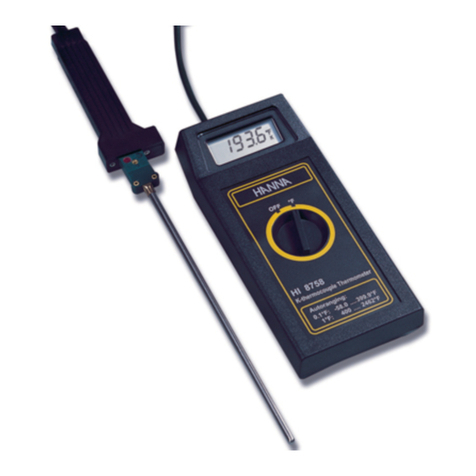
Hanna Instruments
Hanna Instruments HI 8757 instruction manual

ZALMAN
ZALMAN CNPS9500 AM2 user manual
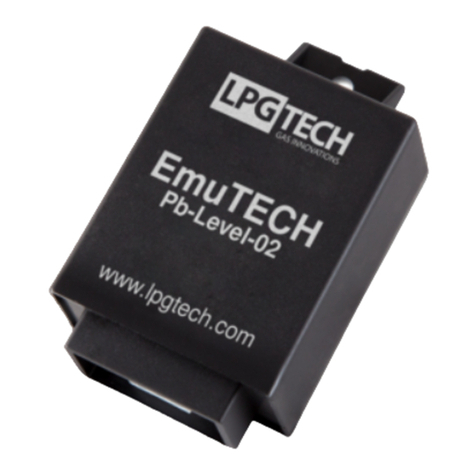
LPGTECH
LPGTECH EmuTECH Pb-Level-02 quick start guide
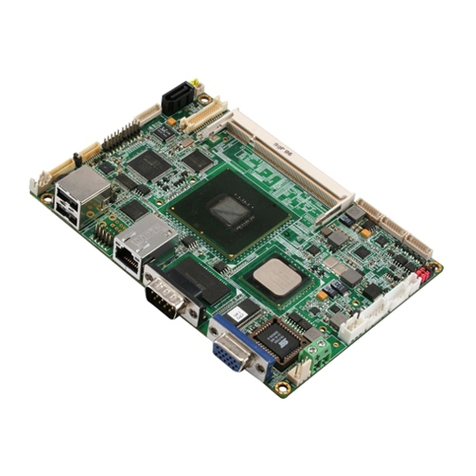
Aaeon
Aaeon GENE-U15B manual

American Megatrends
American Megatrends Olympus III 875 Series quick hardware installation guide
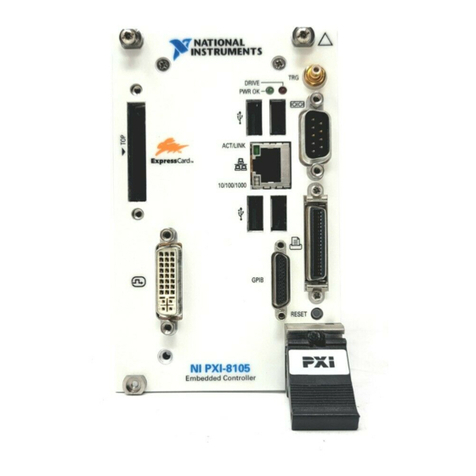
National Instruments
National Instruments NI PXIe-8105 user manual
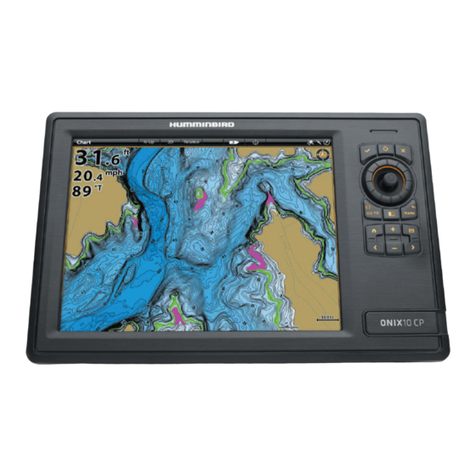
Humminbird
Humminbird SmartStrike Map Card Accessory manual

Noctua
Noctua NF-A4x10 5V user manual
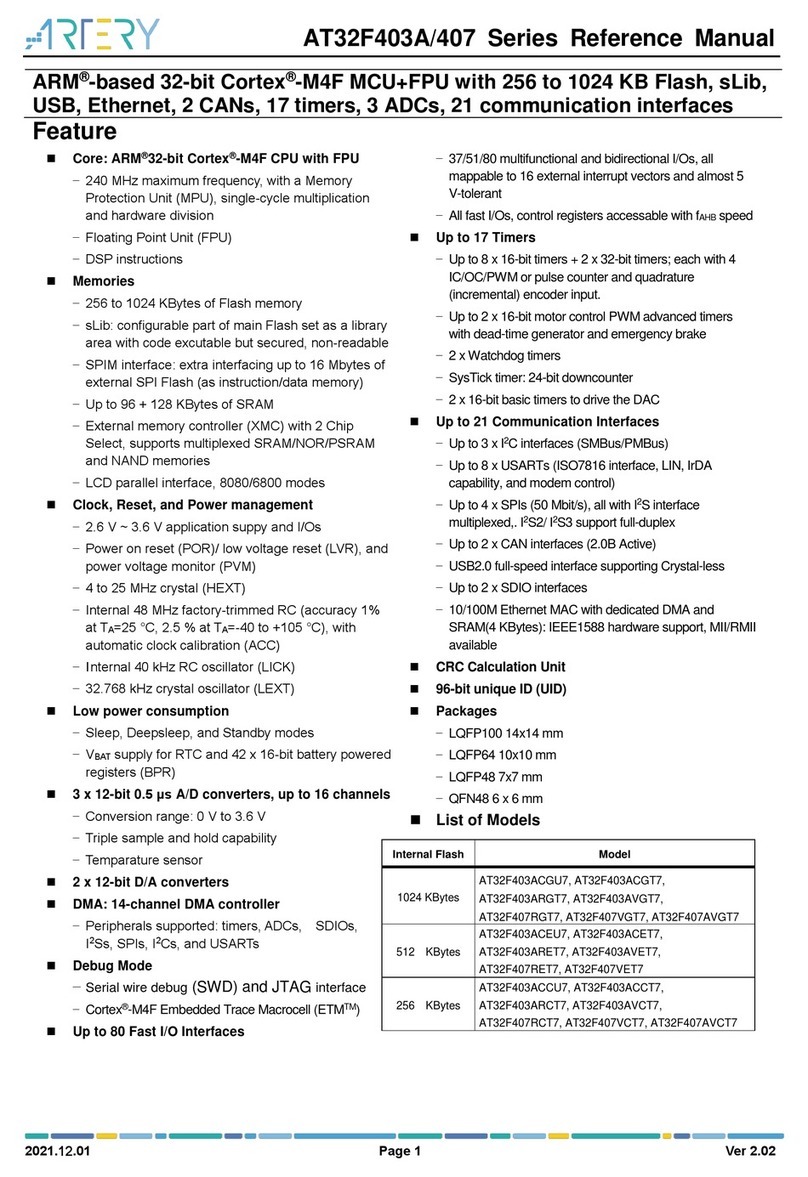
ARTERY
ARTERY AT32F403A Series Reference manual

Matrox
Matrox RT.X2 Quick installation guide
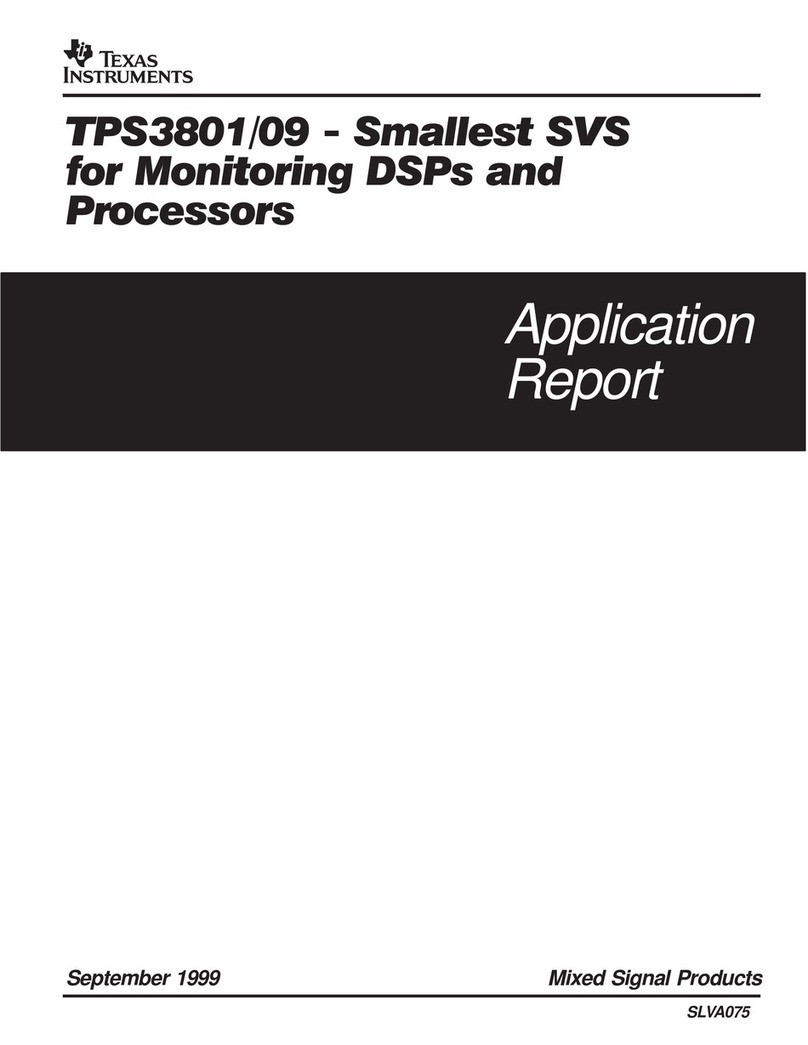
Texas Instruments
Texas Instruments TPS3801 Application report
NXP Semiconductors
NXP Semiconductors MCUXpresso IDE MQX RTOS Troubleshooting and Debug Guide

